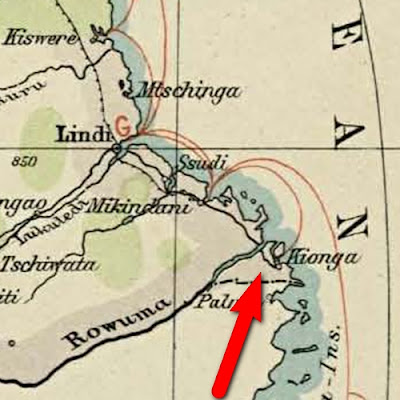May 29, 1916 Scott 1 1/2c on 100r blue on blue
"Kionga" red overprint/surcharge on Lourenco Marques Stamp
Quick HistoryThe border of German East Africa and Portuguese East Africa followed the Rovuma river. The exception was at the Rovuma river outlet to the Indian Ocean, where the Germans had established an outpost on the south side of the river.
This outpost was called Kionga (now Quionga), and had a population of 4,000 in 1910. This small area of 200 square miles (550 square kilometers) became known as the "Kionga Triangle" because of subsequent events that occurred during WW I.
1914 Border between German East Africa and Portuguese East Africa
Red arrow on Kionga Triangle
The illustrated map shows the borders between the two colonial possessions in 1914. Note the small "Kionga Triangle" of land just south of the Rovuma river outlet to the Indian Ocean. This was part of German East Africa.
Closeup of "Kionga Triangle" (Red arrow)
Portugal entered the war on the Allied side on March 9, 1916. Portugal elected to attack the Kionga Triangle, which it had coveted since 1887. Though the Germans were quite occupied with the British and Belgian advances into German East Africa, it still was not easy for the Portuguese troops.
Portuguese trenches on the south side of the Rovuma River
The Portuguese garrison took Kionga. Then they attempted to occupy the north bank of the Rovuma River, but had a heavy loss of 33 men. They retreated to the south side of the river and remained there.
Portuguese troops occupying Kionga
In the meantime postage stamps from Lourenco Marques (Now the city of Maputo, and the Capital of Mozambique) were overprinted/surcharged for use in Kionga.
Subsequently, the Treaty of Versailles awarded the Kionga Triangle to the newly named Portuguese colony of Mozambique.
The larger portion of the rest of German East Africa was mandated to Britain (Tanganyika), while a smaller north-western portion was given to Belgium ( Ruandi-Urundi).
The Scott Classic Specialized catalogue has, for Kionga, the 1916 four stamp set of overprinted/surcharged Lourenco Marques Scott 149 100r blue on blue stamps.
That's it: Four stamps. ;-)
The CV for each stamp is $10+ used, $20+ unused.
A closer look at the stamp issue
100 Centovos = 1 Escudo
100 Centovos = 1 Escudo
The four stamp set all use the basic Lourenco Marques Scott 149, which was then overprinted "Kionga", and has a different surcharge for each stamp.
The Kionga set was released May 29, 1916 for presumptively the use of occupying Portuguese troops- and in no small measure- to add international credibility for the land spoils of war.
Deep Blue
Deep Blue (Steiner) has one page for Kionga, and, as one would expect, provides four spaces for the entire philatelic output for Kionga. The territory became part of Mozambique after WW I.
The '69 Big Blue
Big Blue
Big Blue '69, on one line on one page (sharing with Karelia, Kiachau, and Marienwerder), has four spaces for the entire output of Kionga. Yes, BB includes spaces for all the stamps.
The '69 page is located after the Kenya, Uganda, Tanganyika section.
The '41/'43/'47 editions likewise have Kionga after Kenya, Uganda, Tanganyika.
The '69 page is located after the Kenya, Uganda, Tanganyika section.
The '41/'43/'47 editions likewise have Kionga after Kenya, Uganda, Tanganyika.
All four spaces cross the CV $10+ threshold.
Checklist
1916
1,2,3,4,
End
Comments
A) Expensive stamps ($10 threshold):
Scott 1 1/2c on 100r blue on blue ($10+)
Scott 2 1c on 100r blue on blue ($10+)
Scott 3 2 1/2c on 100r blue on blue ($10+)
Scott 4 5c on 100r blue on blue ($10+)
1922 map of east Africa
Note the "Kionga Triangle" here is mislabled as part of Tanganyika
Out of the Blue
What is more fun than learning about the detailed history of WW I?
When stamp issues are involved. ;-)
Note: Maps, pics, appear to be in the public domain. (Red arrows on maps are my addition.)
Links
Kionga - Bud's Big Blue
Links
Kionga - Bud's Big Blue
Have a comment?










Insider joke, customer to stamp dealer, "Do you have any Kionga airmails".
ReplyDeleteI would be surprised if the Dealer even knew about Kionga. ;-)
DeleteJim, the photo of your Big Blue album page that features four of the most obscure stamp issuing entities is truly a trip in itself! Much like you, I am quite taken with those dimly remembered, short-lived countries.
ReplyDeleteI love obscure - the more obscure country, the better. ;-)
Delete